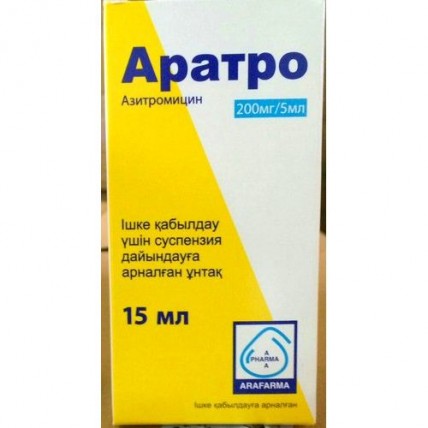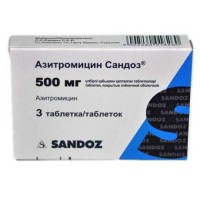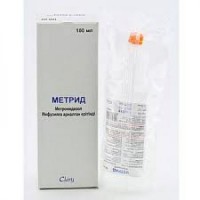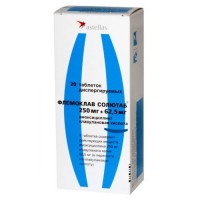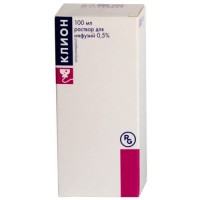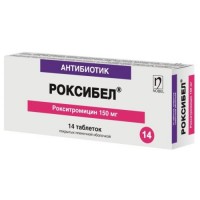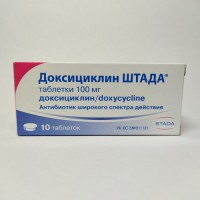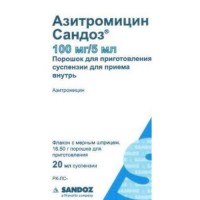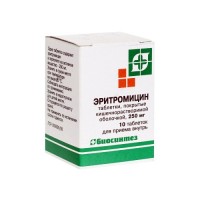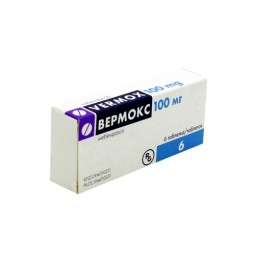Aratro 200 mg / 5 ml 15 ml powder for suspension
- $23.60
The instruction for medical use of Aratro Torgovoye medicine Aratro Mezhdunarodnoye's name the unlicensed name Azithromycin Dosage Form Powder for preparation of oral suspension of 200 mg / 5 ml, 15 ml Structure of 5 ml of drug contain active agent – azithromycin of a dihydrate 209.62 is equivalent to azithromycin of 200.00 mg, excipients: sucrose, hydroxypropyl cellulose monohydrate, trisodium phosphate anhydrous, ksantum GUM, fragrance cherry (9/021095), fragrance vanilla (9/024307), fragrance banana (9/028122), the water purified. The description Crystal powder, colors of ivory with a characteristic fruit smell. Pharmacotherapeutic group Antimicrobial drugs for system use. Macroleads. Azithromycin. The ATX J01FA10 code the Pharmacological Pharmacokinetics Azithromycin properties at oral administration is quickly soaked up from digestive tract thanks to acidic environment resistance and lipophilicity. After single dose 37% of azithromycin are inside soaked up. The maximum concentration in blood plasma after reception of 500 mg of drug is reached in 2.5-2.96 h and makes about 0.4 mg/ml. Azithromycin well gets into airways, bodies and fabrics of an urogenital highway, into a prostate, into skin and soft tissues. High concentration in fabrics (is 50 times higher, than in plasma) and also long elimination half-life are caused by low linking of azithromycin with proteins of blood plasma and also its ability to get into eukaryotic cells and to concentrate in the environment with a low indicator rn, the surrounding lysosome. The ability of azithromycin to collect mainly in lysosomes is especially important for elimination of intracellular activators. Researches showed that phagocytes deliver azithromycin to places of localization of an infection where it is released in the course of phagocytosis. But, despite high concentration in phagocytes, azithromycin does not affect their function. Azithromycin remains in bactericidal concentration in the inflammation center within 5-7 days after reception of the last dose that allows to apply its short (3-day and 5-day) courses of treatment. It is metabolized generally in a liver, metabolites are not active. Drug generally with bile in an invariable look is removed, about 6% of the accepted dose are removed by kidneys. A pharmacodynamics Active agent of the drug Aratro – azithromycin, an antibiotic of a broad spectrum of activity, the representative of a class of azaleads, a subclass of macroleads. Possesses bacteriostatic action, but during creation of high concentrations in the inflammation center, renders bactericidal effect. Azithromycin suppresses synthesis of protein in sensitive microorganisms, is active concerning the majority of gram-positive, gram-negative, anaerobic, intracellular and other bacteria. MIC90 ≤ 0.01 µg/мл Mycoplasma pneumoniae Haemophilus ducreyi MIC90 0.01 - 0.1 µg/мл Moraxella catarrhalis Propionibacterium acnes Gardnerella vaginalis Actinomyces species Bordetella pertussis Borrelia burgdorferi Mobiluncus species MIC90 0.1 - 2.0 µg/мл Haemophilus influenzae Streptococcus pyogenes Haemophilus parainfluenzae Streptococcus pneumoniae Legionella pneumophila Streptococcus agalactiae Neisseria meningitidis Streptococcus viridans Neisseria gonorrhoeae Streptococcus group C, F, G Helicobacter pylori Peptococcus species Campylobacter jejuni Peptostreptococcus Pasteurella multocida Fusobacterium necrophorum Pasteurella haemolytica Clostridium perfringens Brucella melitensis Bacteroides bivius Bordetella parapertussis Chlamydia trachomatis Vibrio cholerae Chlamydia pneumoniae Vibrio parahaemolyticus Ureaplasma urealyticum Plesiomonas shigelloides Listeria monocytogenes Staphylococcus epidermidis Staphylococcus aureus * (*эритромицин – a sensitive strain) MIC90 2.0 - 8.0 µg/мл Escherichia coli Bacteroides fragilis Salmonella enteritidis Bacteroides oralis Salmonella typhi Clostridium difficile Shigella sonnei Eubacterium lentum Yersinia enterocolitica Fusobacterium nucleatum Acinetobacter calcoaceticus Aeromonas hydrophilia Indications Is applied to treatment of the infectious and inflammatory diseases caused by microorganisms, sensitive to drug: - respiratory infection, including pharyngitis/tonsillitis, sinusitis, average otitis - lower respiratory tract infections, including acute exacerbation of chronic bronchitis, not hospital pneumonia - infections of skin and soft tissues: the migrating erythema (initial stage of a disease of Lyme), erysipelatous inflammation, impetigo, secondary pyodermatoses - the infections of a stomach and a duodenum caused by Helicobacter pylori the Route of administration and Aratro's doses in the form of oral suspension accept 1 time a day in 1 hour prior to or in 2 hours after a meal. Infections of upper and lower airways, skin and soft tissues (except for the chronic migrating erythema) the Course dose makes 30 mg/kg two schemes of treatment Are applied: 10 mg/kg of body weight once a day within 3 days of 10 mg/kg of body weight in the first day and on 5 mg/kg of body weight from the 2nd to the 5th day. To children drug is appointed proceeding from weight: Aratro body weight, powder for preparation of oral suspension of 200 mg / 5 ml of 15-25 kg 5 ml (200 mg) of 25-34 kg 7.5 ml (300 mg) of 35-44 kg 10 ml (400 mg) ≥ 45 kg 12.5 ml (500 mg) the Chronic migrating erythema the Course dose of drug makes 60 mg/kg: once in day on 20 mg/kg - in the 1st day and on 10 mg/kg – in the subsequent, from 2 to 5 days. The diseases of a stomach and a 12-perstny gut associated with Helicobacter pylori: 20 mg/kg of body weight once a day in combination with anti-secretory means and other medicines. In case the dose of drug was passed, it needs to be accepted at once, and then to accept the subsequent doses at an interval of the 24th hour. Renal failure. Patients with insignificant dysfunction of kidneys (SKF of 10-80 ml/min.) have no need to change a dose. Patients with heavy renal failures (SKF & lt, 10 ml/min.) need to apply azithromycin with care. Liver failure. As azithromycin is metabolized in a liver and removed with bile, drug should not be used to patients with a serious illness of a liver. The researches directed to studying influence of azithromycin on function of a liver were not conducted. Way of preparation of suspension. For receiving suspension of 15 ml by means of the measured syringe to add 7.5 ml of svezhekipyacheny and chilled water to powder. Before reception the bottle contents are carefully shaken up before receiving uniform suspension. Directly after intake of suspension to the child allow to drink several drinks of liquid to wash away and swallow the remained amount of suspension in an oral cavity. Side effects Often - a headache - nausea, vomiting, diarrhea, an abdominal pain - reduction of quantity of leukocytes, increase in quantity of eosinophils, decrease in bicarbonate of blood, increase in quantity of basophiles, increase in quantity of monocytes, increase in quantity of neutrophils Infrequently - a constipation, a meteorism, dyspepsia, gastritis, a dysphagy, an abdominal distension, dryness in a mouth, an eructation, ulcers in a mouth, hypersecretion of sialadens - dizziness, drowsiness, a food faddism, paresthesias - hearing disorder, dizziness - a cardiopalmus - short wind, nasal bleeding - a disorder of vision - anorexia - an osteoarthritis, myalgia, a dorsodynia, neck pain - nervousness, insomnia - a leukopenia, a neutropenia, an eosinophilia - candidiasis, vaginal infections, pneumonia, fungal infections, a bacterial infection, pharyngitis, a gastroenteritis, respiratory disorders, rhinitis, candidiasis - inflows - rash, an itching, urticaria, dermatitis, xeroderma, a hyperhidrosis - a Quincke's disease, hypersensitivity - a dysuria, renal pain - a metrorrhagia, defeat of testicles - hypostasis, an asthenia, an indisposition, fatigue, a face edema, a stethalgia, fever, pain, peripheral hypostases - increase in level of aspartate aminotransferase, increase in level aminotransferase alanine, increase in bilirubin in blood, increase in urea in blood, increase in creatinine of blood, abnormal level of potassium in blood, increase in level of alkaline phosphatase in blood, increase in level of chloride, increase in level of glucose, increase in level of thrombocytes, reduction of a hematocrit, increase in bicarbonate, the abnormal level of sodium Seldom - agitation - abnormal hepatic function, cholestatic jaundice - reactions of photosensitivity Is unknown - pseudomembranous colitis - thrombocytopenia, hemolytic anemia - anaphylactic reaction - aggression, alarm, nonsense, hallucinations - faints, spasms, paresthesias, psychomotor hyperactivity, an anosmia, an ageusia, a parosomiya, a myasthenia - a hearing disorder, up to deafness and/or sonitus - bidirectional tachycardia and arrhythmia, including ventricular tachycardia, lengthening of an interval of QT on the ECG - hypotension - pancreatitis, decolouration of language - a liver failure (in rare instances with a lethal outcome) lightning hepatitis, liver necrosis - Stephens-Johnson's syndrome, a toxic epidermal necrolysis, a multiformny erythema - an arthralgia - an acute renal failure, interstitial nephrite the Side reactions connected with prevention and treatment of the infections caused by the Mycobacterium Avium complex are possible or probable, based on clinical trials and experience of post-marketing observation. These side reactions differ on type or frequency from the reactions reported for dosage forms with immediate release or the prolonged action: A system and organ class Very often Often Infrequently Disturbances from a metabolism and food Disturbance anorexia from nervous system dizziness, a headache, paresthesias, disturbances of taste the Disturbance hypesthesia from an organ of sight the Disturbance disorder of vision from an organ of hearing and balance deafness a hearing disorder, sonitus of Disturbance from body of heart the Disturbance cardiopalmus from digestive tract diarrhea, an abdominal pain, nausea, a constipation, discomfort in a stomach, a soft chair of Disturbance from a liver and biliary tract Disturbance hepatitis from skin and hypodermic fabrics rash, naggers Sindrom of Stephens - Johnson, reaction of photosensitivity of Disturbance from skeletal and muscular and connective tissue an arthralgia the General disturbances and reactions in the injection site fatigue an asthenia, the Contraindication indisposition - hypersensitivity to antibiotics of group of macroleads - heavy disturbances of functions of a liver and kidneys - the lactation period - children's age up to 6 months Medicinal interactions Antacids: When studying influence of simultaneous use of antacids on pharmacokinetics of azithromycin did not note changes of bioavailability though the maximum concentration of azithromycin in blood plasma decreased by 25%. Patients should not accept azithromycin and antacids at the same time. Tsetirizin: At healthy volunteers, did not lead joint reception of a 5-day rate of azithromycin from tsetiriziny 20 mg in an equilibrium state to pharmacokinetic interaction and significant change in QT interval. Didanozin (didezoksiinozin): Joint reception of 1200 mg/days of azithromycin of 400 mg/days of a didanozin at 6 HIV-positive patients, does not influence an equilibrium condition of pharmacokinetics of a didanozin in comparison with placebo. Digoxin (P-gp substrates): Simultaneous use of makrolidny antibiotics, including azithromycin, with P-glycoprotein substrates, such as digoxin leads to increase in serumal levels of substrates of a P-glycoprotein. Therefore at simultaneous use of azithromycin and substrates of a P-glycoprotein, such as digoxin, it is necessary to remember a possibility of increase in concentration of substrates of a P-glycoprotein in serum. Zidovudine: At single use of 1000 mg and repeated use of 1200 mg or 600 mg of azithromycin the insignificant influence on plasma pharmacokinetics or removal with urine of a zidovudine or its glyukuronidny metabolites is revealed. However intake of azithromycin increased concentration of a fosforilirovanny zidovudine (clinically active metabolite) in mononukleara of peripheral blood. There is uncertain a clinical importance of these indicators, but perhaps they can be useful to patients. Azithromycin does not interact with the system of P450 cytochrome of a liver. He does not participate in pharmacokinetic medicinal interaction as erythromycin and other macroleads. Azithromycin does not induce or inactivates P450 cytochrome by means of a complex cytochrome metabolite. Ergotamine derivatives: Because of a theoretical possibility of development of an ergotism, simultaneous use of azithromycin with derivatives of an ergot is not recommended. Pharmacokinetic researches were conducted with azithromycin and the following drugs with known R450-cytochrome for the mediated metabolism. Atorvastatin: Joint introduction of an atorvastatin (10 mg daily) and azithromycin (500 mg daily) did not change concentration of an atorvastatin in blood plasma (on the basis of the analysis of HMG CoA-reductases). Nevertheless, post-marketing cases of a rhabdomyolysis at the patients receiving azithromycin with statines are registered. Carbamazepine: In a research of pharmacokinetic interaction of azithromycin on healthy volunteers, drug had no considerable impact on carbamazepine level in blood plasma or on its active metabolites. Cimetidinum: Change of pharmacokinetics of azithromycin was not noted in the pharmacokinetic research studying action of the single dose of Cimetidinum accepted in 2 hours prior to azithromycin on azithromycin pharmacokinetics. Coumarinic oral anticoagulants: In pharmacokinetic researches of interaction, azithromycin does not change anticoagulating effect of the single dose of 15 mg of warfarin entered to healthy volunteers. During the post-marketing period messages about strengthening of anti-coagulation after joint intake of azithromycin and oral coumarinic anticoagulants are received. Though relationship of cause and effect is not established, it is necessary to consider the frequency of monitoring of a prothrombin time, when prescribing azithromycin the patient receiving oral anticoagulants like coumarin. Cyclosporine: In a pharmacokinetic research at healthy volunteers who within 3 days orally received 500 mg/day of azithromycin and then once orally of 10 mg/kg of cyclosporine, Cmax and AUC0-5 of cyclosporine were much raised. Therefore, it is necessary to show care before considering simultaneous administration of these drugs. If joint administration of these drugs is necessary, it is necessary to control levels of cyclosporine and as appropriate to correct a dose. Efavirenz: Joint reception of a single dose of azithromycin of 600 mg and 400 mg of an efavirenz a day within 7 days does not lead to clinically significant pharmacokinetic interactions. Flukonazol: Joint reception of a single dose of 1200 mg of azithromycin does not change pharmacokinetics of a single dose of 800 mg of a flukonazol. The general influence and elimination half-life of azithromycin did not change at joint introduction with flukonazoly, however, clinically insignificant decrease in Cmax (18%) of azithromycin was observed. Indinavir: Joint reception of a single dose of 1200 mg of azithromycin did not make significant impact on pharmacokinetics of the indinavir entered in a dosage of 800 mg three times a day within 5 days. Methylprednisolonum: In a research of pharmacokinetic interaction at healthy volunteers azithromycin did not show considerable influence on Methylprednisolonum pharmacokinetics. Midazolam: At healthy volunteers, joint introduction with azithromycin of 500 mg/days within 3 days does not cause clinically significant changes in pharmacokinetics and a pharmacodynamics of a single dose of 15 mg of midazolam. Nelfinavir: Joint administration of azithromycin (1200 mg) and nelfinaviry in an equilibrium state (750 mg three times a day) led to increase in concentration of azithromycin. Clinically significant side effects were not observed and dose adjustment is not required. Rifabutin: Simultaneous use of azithromycin and a rifabutin did not affect concentration of these drugs in blood plasma. The neutropenia was revealed at simultaneous use of azithromycin and a rifabutin. Though the neutropenia was connected with use of a rifabutin, the causal relationship was not established with a concomitant use of azithromycin. Sildenafil: At normal healthy male volunteers, it is not received to a dokazata
of stvo of influence of azithromycin (500 mg daily within 3 days) on AUC and Cmax of a sildenafil or its main circulating metabolite. Terfenadin: In pharmacokinetic researches it was not reported about interaction between azithromycin and terfenadiny. In certain cases it is not possible to exclude interaction probability completely. Nevertheless, the specific evidence that such interaction took place was not obtained. Theophylline: The evidence of clinically significant pharmacokinetic interaction between azithromycin and theophylline at their simultaneous use by healthy volunteers is not obtained. To triazoles: 14 healthy volunteers, joint administration of azithromycin have 500 mg for 1 day and 250 mg for 2 day from 0.125 mg of a triazolam for the 2nd day had no significant effect on any of pharmacokinetic variables for a triazolam in comparison with joint introduction of a triazolam and placebo. Trimethoprimum / sulfamethoxazole: Joint administration of DS Trimethoprimum / sulfamethoxazole (160 mg / 800 mg) within 7 days with azithromycin of 1200 mg for the 7th day had no significant effect on the maximum concentration, the general influence or removal of Trimethoprimum or sulfamethoxazole. Concentration of azithromycin in serum resembled that, observed in other researches. Special instructions As well as in a case with erythromycin and other macroleads, it was reported about rare serious allergic reactions, including a Quincke's edema and anaphylaxis (in rare instances from the death). Some of these reactions to azithromycin lead to development of recurrent symptoms and demand longer period of observation and treatment. The liver is the main body for azithromycin removal therefore patients should appoint azithromycin with care with the profound disease of a liver. Cases of the lightning hepatitis which is potentially leading to a life-threatening liver failure were reported. Some patients, perhaps, had existing diseases of a liver or they accepted other hepatotoxic medicines. In case of signs and symptoms of dysfunction of a liver, such as quickly developing asthenia connected with jaundice, dark urine, tendency to bleedings or hepatic encephalopathy to immediately carry out functional trials livers/analyses. At development of dysfunction of a liver to stop intake of azithromycin. At the patients receiving ergot derivatives, emergence of an ergotism is provoked by a concomitant use of some makrolidny antibiotics. There are no data on a possibility of interaction between an ergot and azithromycin. Nevertheless, because of a theoretical possibility of development of an ergotism, azithromycin and derivatives of an ergot are accepted separately. As well as at reception of any antibiotics, the observation of signs of superinfection caused by resistant microorganisms including mushrooms is recommended. The diarrhea caused by Clostridium difficile was reported in all cases of use of antibacterial agents, including azithromycin, and can vary on severity from slight diarrhea to fatal colitis. Treatment by antibacterial agents changes normal flora of intestines that conducts to the overgrowth of C. difficile. C. difficile produces A and B toxins which contribute to the development of CDAD. The strain producing C. difficile hyper toxin results in the increased incidence and mortality as these infections can be resistant to antimicrobic therapy and can demand performing colectomy. CDAD has to be considered at all patients who complain of diarrhea after use of antibiotics. The careful anamnesis is necessary as CDAD can develop in two months after introduction of antibacterial agents. At patients with a heavy renal failure (SKF & lt, 10 ml/min.) observed 33% increase in system influence of azithromycin. The prolonged warm repolarization and lengthening of an interval of QT leading to risk of developing cardiac arrhythmia and bidirectional tachycardia were noted at treatment with other macroleads, including azithromycin. The following states increase risk of developing ventricular arrhythmias (including bidirectional tachycardia) which can lead to cardiac arrest therefore azithromycin should be applied with care at patients with the current proaritmogenny states (especially women and elderly patients), for example: • with the congenital or documentary confirmed lengthening of an interval of QT • which undergo now treatment with other active agents known as QT extending an interval, for example antiarrhytmic means of the class IA (quinidine and procaineamide) and class III (dofetilid, Amiodaronum and sotalol), tsizaprid and terfenadin, antipsychotic means, such as Pimozidum, antidepressants, such as to tsitalopra, and ftorkhinolona, such as moxifloxacin and levofloxacin • with disturbance of electrolytic balance, especially in cases of a hypopotassemia and a hypomagnesiemia • with clinically significant bradycardia, cardiac arrhythmia or heavy heart failure. Aggravation of symptoms of a myasthenia and the new beginning of a syndrome of a myasthenia were registered at the patients receiving azithromycin. Penicillin, as a rule, is choice drug at treatment of laryngitis/tonsillitis, the caused Streptococcus pyogenes and is used as prevention in sharp rheumatic fever. Azithromycin, as a rule, is effective against streptococcal pharyngitis, but there is no information, concerning its efficiency for prevention of acute rheumatic fever. Safety and efficiency of the Mycobacterium Avium complex for prevention or treatment at children are not established. Sucrose. Drug contains sucrose. Patients with rare hereditary diseases of intolerance of fructose, a sprue of glucose and a galactose or sakharazo-izomaltazny insufficiency should not take this drug. Pregnancy Use of drug at pregnancy is possible only when the expected advantage exceeds potential risk for a fruit. The feature of influence of medicine on ability to run the vehicle or potentially dangerous Aratro mechanisms does not influence speed of response at control of vehicles and work with other mechanisms. The overdose Overdose by makrolidny antibiotics is shown by nausea, vomiting and diarrhea. In case of overdose it is necessary to accept activated carbon and to carry out the symptomatic therapy directed to maintenance of vital signs of an organism. A form of release and packing On 15 ml in bottles from dark glass with the screwing-up lid from aluminum. On 1 bottle with the syringe for dosing and a nozzle for the syringe together with the instruction for medical use in the state and Russian languages place in a pack from cardboard. To Store storage conditions in the dry, protected from light place, at a temperature not over 25 about S. Hranit out of children's reach! The use period after opening of a bottle no more than 5 days. 4 years not to apply a period of storage after an expiration date. Prescription status According to the prescription ARAFARMA GROUP, S.A. Producer, Spain the location Address: With / the Big-head Gabrielle de San Antonio of 6-10 19180 Marchamalo - Guadalajara Spain EL company (EL company) LLP 050022, Almaty, Masangchi St., 98a, office 41
to Develop the Address of the organization accepting claims from consumers on quality of the products (goods) and responsible for post-registration observation in the territory of the Republic of Kazakhstan
of stvo of influence of azithromycin (500 mg daily within 3 days) on AUC and Cmax of a sildenafil or its main circulating metabolite. Terfenadin: In pharmacokinetic researches it was not reported about interaction between azithromycin and terfenadiny. In certain cases it is not possible to exclude interaction probability completely. Nevertheless, the specific evidence that such interaction took place was not obtained. Theophylline: The evidence of clinically significant pharmacokinetic interaction between azithromycin and theophylline at their simultaneous use by healthy volunteers is not obtained. To triazoles: 14 healthy volunteers, joint administration of azithromycin have 500 mg for 1 day and 250 mg for 2 day from 0.125 mg of a triazolam for the 2nd day had no significant effect on any of pharmacokinetic variables for a triazolam in comparison with joint introduction of a triazolam and placebo. Trimethoprimum / sulfamethoxazole: Joint administration of DS Trimethoprimum / sulfamethoxazole (160 mg / 800 mg) within 7 days with azithromycin of 1200 mg for the 7th day had no significant effect on the maximum concentration, the general influence or removal of Trimethoprimum or sulfamethoxazole. Concentration of azithromycin in serum resembled that, observed in other researches. Special instructions As well as in a case with erythromycin and other macroleads, it was reported about rare serious allergic reactions, including a Quincke's edema and anaphylaxis (in rare instances from the death). Some of these reactions to azithromycin lead to development of recurrent symptoms and demand longer period of observation and treatment. The liver is the main body for azithromycin removal therefore patients should appoint azithromycin with care with the profound disease of a liver. Cases of the lightning hepatitis which is potentially leading to a life-threatening liver failure were reported. Some patients, perhaps, had existing diseases of a liver or they accepted other hepatotoxic medicines. In case of signs and symptoms of dysfunction of a liver, such as quickly developing asthenia connected with jaundice, dark urine, tendency to bleedings or hepatic encephalopathy to immediately carry out functional trials livers/analyses. At development of dysfunction of a liver to stop intake of azithromycin. At the patients receiving ergot derivatives, emergence of an ergotism is provoked by a concomitant use of some makrolidny antibiotics. There are no data on a possibility of interaction between an ergot and azithromycin. Nevertheless, because of a theoretical possibility of development of an ergotism, azithromycin and derivatives of an ergot are accepted separately. As well as at reception of any antibiotics, the observation of signs of superinfection caused by resistant microorganisms including mushrooms is recommended. The diarrhea caused by Clostridium difficile was reported in all cases of use of antibacterial agents, including azithromycin, and can vary on severity from slight diarrhea to fatal colitis. Treatment by antibacterial agents changes normal flora of intestines that conducts to the overgrowth of C. difficile. C. difficile produces A and B toxins which contribute to the development of CDAD. The strain producing C. difficile hyper toxin results in the increased incidence and mortality as these infections can be resistant to antimicrobic therapy and can demand performing colectomy. CDAD has to be considered at all patients who complain of diarrhea after use of antibiotics. The careful anamnesis is necessary as CDAD can develop in two months after introduction of antibacterial agents. At patients with a heavy renal failure (SKF & lt, 10 ml/min.) observed 33% increase in system influence of azithromycin. The prolonged warm repolarization and lengthening of an interval of QT leading to risk of developing cardiac arrhythmia and bidirectional tachycardia were noted at treatment with other macroleads, including azithromycin. The following states increase risk of developing ventricular arrhythmias (including bidirectional tachycardia) which can lead to cardiac arrest therefore azithromycin should be applied with care at patients with the current proaritmogenny states (especially women and elderly patients), for example: • with the congenital or documentary confirmed lengthening of an interval of QT • which undergo now treatment with other active agents known as QT extending an interval, for example antiarrhytmic means of the class IA (quinidine and procaineamide) and class III (dofetilid, Amiodaronum and sotalol), tsizaprid and terfenadin, antipsychotic means, such as Pimozidum, antidepressants, such as to tsitalopra, and ftorkhinolona, such as moxifloxacin and levofloxacin • with disturbance of electrolytic balance, especially in cases of a hypopotassemia and a hypomagnesiemia • with clinically significant bradycardia, cardiac arrhythmia or heavy heart failure. Aggravation of symptoms of a myasthenia and the new beginning of a syndrome of a myasthenia were registered at the patients receiving azithromycin. Penicillin, as a rule, is choice drug at treatment of laryngitis/tonsillitis, the caused Streptococcus pyogenes and is used as prevention in sharp rheumatic fever. Azithromycin, as a rule, is effective against streptococcal pharyngitis, but there is no information, concerning its efficiency for prevention of acute rheumatic fever. Safety and efficiency of the Mycobacterium Avium complex for prevention or treatment at children are not established. Sucrose. Drug contains sucrose. Patients with rare hereditary diseases of intolerance of fructose, a sprue of glucose and a galactose or sakharazo-izomaltazny insufficiency should not take this drug. Pregnancy Use of drug at pregnancy is possible only when the expected advantage exceeds potential risk for a fruit. The feature of influence of medicine on ability to run the vehicle or potentially dangerous Aratro mechanisms does not influence speed of response at control of vehicles and work with other mechanisms. The overdose Overdose by makrolidny antibiotics is shown by nausea, vomiting and diarrhea. In case of overdose it is necessary to accept activated carbon and to carry out the symptomatic therapy directed to maintenance of vital signs of an organism. A form of release and packing On 15 ml in bottles from dark glass with the screwing-up lid from aluminum. On 1 bottle with the syringe for dosing and a nozzle for the syringe together with the instruction for medical use in the state and Russian languages place in a pack from cardboard. To Store storage conditions in the dry, protected from light place, at a temperature not over 25 about S. Hranit out of children's reach! The use period after opening of a bottle no more than 5 days. 4 years not to apply a period of storage after an expiration date. Prescription status According to the prescription ARAFARMA GROUP, S.A. Producer, Spain the location Address: With / the Big-head Gabrielle de San Antonio of 6-10 19180 Marchamalo - Guadalajara Spain EL company (EL company) LLP 050022, Almaty, Masangchi St., 98a, office 41
to Develop the Address of the organization accepting claims from consumers on quality of the products (goods) and responsible for post-registration observation in the territory of the Republic of Kazakhstan
